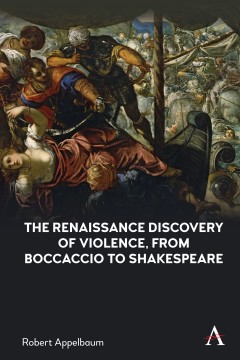The Renaissance Discovery of Violence, from Boccaccio to Shakespeare
By Robert Appelbaum
Other Formats Available:
- About This Book
- Reviews
- Author Information
- Series
- Table of Contents
- Links
- Podcasts
About This Book
Many have wondered why the works of Shakespeare and other early modern writers are so filled with violence, with murder and mayhem. This work explains how and why, putting the literature of the European Renaissance in the context of the history of violence. Personal violence was on the decline in Europe beginning in the fifteenth century, but warfare became much deadlier and the stakes of war became much higher as the new nation-states vied for hegemony and the New World became a target of a shattering invasion. The development of firearms caused a great change in the conduct of war and in the codes of militancy that warriors adopted. (By the early sixteenth century, it became apparent that the purpose of warfare was not to obtain a ritual advantage over one’s opponents, but to kill as many people as possible.) Meanwhile, writers became much more sensitive to the realities of violence and developed new genres to cope with them, including the novella, the epic romance, vernacular tragedy and even the utopia, whose first example, by Thomas More, was written as a critique of violence. There are times when Renaissance writers seem to celebrate violence, but more commonly they anatomized it, and were inclined to focus on victims as well as warriors on the horrors of violence as well as the need for force to protect national security and justice. In Renaissance writing, violence has lost its innocence.
This study, the first of its kind, looks at key Renaissance texts in the novelle collection, the humanist satire, epic-romance, and vernacular tragedy. Literature in English, French, Italian, Spanish and Latin is considered. The emphasis is, on the one hand, on the performative aspects of the genres and modes considered, and, on the other, the performative aspects of violence itself. The study places both violence and its representations in the context of major historical events, like the Sack of Rome, and developments in the history of violence per se. Authors considered include Giovanni Boccaccio, Matteo Bandello, Marguerite de Navarre, Erasmus of Rotterdam, Thomas More, Matteo Maria Boiardo, Ludovico Ariosto, Torquato Tasso, Edmund Spenser, Giovanni Batista Giraldi Cinthio, Robert Garnier, Thomas Kyd and William Shakespeare.
Reviews
“In Robert Appelbaum’s Renaissance Discovery of Violence, the ‘discovery’ in question takes multiple forms: as a re-invention of violence through new ritual shapes and physical instruments, but also as a representation of violence through art and language, and an uncovering of the moral economies that underlie its use. The resulting study, both wide-ranging and incisively detailed, revels in the nuance and complexity of its subject-matter.” — Bruce Boehrer, Bertram H. Davis Professor, English Department, Florida State University, US
“Robert Appelbaum has done it again with this sweeping study of how European attitudes toward violence shifted and the enormous repercussions this held for artistic expression.... The book’s readings, taken together, cast breathtaking light upon Shakespeare’s tragedies.” — George Hoffmann, Professor of French, University of Michigan, US
“Renaissance writers differed dramatically on the subject of violence. Some invented new violent delights, some sought an end to violence, but all grappled with the challenge that violence posed to representation. In this learned and energetic study, Robert Appelbaum ‘un-conceals’ the work that violence performs at the heart of the period’s most characteristic genres, shown to us as changing under the forming pressure of acts of violence throughout and beyond Europe. The Renaissance Discovery of Violence is literary and cultural history at its most capacious and revelatory.” — David Currell, American University of Beirut, Lebanon
Author Information
Born in New York City and educated at the University of Chicago and the University of California, Berkeley, Robert Appelbaum is Professor Emeritus of English Literature at Uppsala University, Sweden.
Series
Anthem Studies in Renaissance Literature and Culture
Table of Contents
A Note on the Texts; Acknowledgments; Preface; Chapter One Overture: The Show of Violence; Chapter Two The Moral Economy of Violence in the Renaissance Novella Collection: Straparola, Bandello and Marguerite de Navarre; Chapter Three Pacifism, Erasmus and More; Chapter Four Violence as Labor: The Heroic Narrative; Chapter Five “Tragedy Shows Us What We Must Flee From”; Afterword; Select Bibliography; Index.
Links
Stay Updated
Information
Latest Tweets



